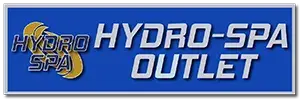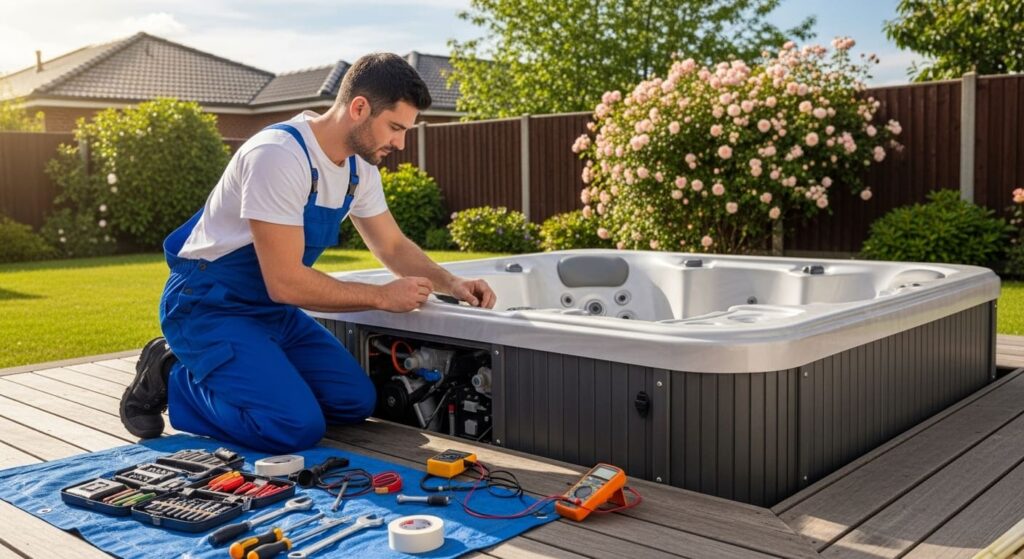For many Woodland Hills homeowners, the heartbeat of the hot tub is the pump. When it runs smoothly, you feel strong, even jets, steady heating, and the quiet assurance that everything beneath the cabinet is in sync. When it struggles, the whole experience falters—water gets sluggish, heaters complain, and the tub never quite feels right. Because our Valley dishes out dry winds, warm days, and cool nights, pumps here face unique stresses. A thoughtful inspection routine tailored to local conditions keeps performance dependable, and if something sounds off or a warning light starts flashing, quick help for hot tub repair gets you back to effortless soaks.
Understanding your pump doesn’t require a technical degree. It helps to visualize two main parts working as a team: the motor that provides the spin and the wet end that moves water through the system. Inside the wet end lives the impeller, which draws water in and pushes it onward; around it are seals and unions that keep moisture where it belongs. When everything is aligned, water flows freely, heaters receive the circulation they need, and jets deliver that satisfying massage. A regular look at this system—listening, feeling for vibration, scanning for moisture—builds familiarity that pays off every time seasons change.
How Pumps Work, in Everyday Terms
Imagine a fan in a sealed housing, only instead of air, it’s moving water. The motor spins the impeller, creating a low-pressure area that pulls water in and a higher-pressure area that pushes it out. From there, water travels through plumbing to the heater and back into the tub through jets. A pressure or flow switch keeps the heater honest, preventing it from firing when circulation is inadequate. That’s why a pump in top form isn’t just about jet strength—it’s about safeguarding the entire system.
Small inefficiencies cascade. A slightly clogged filter forces the pump to work harder. A minor air leak on the suction side introduces bubbles that lead to cavitation, which sounds like a crackling hiss and eats at performance. A worn shaft seal allows moisture to escape, leaving telltale dampness around the motor foot or pump unions. Each of these signals is easy to miss if you rarely peek into the equipment bay, which is why a gentle inspection routine matters.
Local Stresses in Woodland Hills
Our climate puts pumps to the test. Dry winds accelerate evaporation, which can lower water levels enough to pull air into the system if you’re not topping off regularly. Warm days can turn equipment bays into small ovens, especially on south-facing patios, stressing motor bearings and insulation. Then, as the evening cools, condensation can develop on fittings and electronics. These repeated daily swings make tight unions, proper ventilation, and cover discipline more important than you might expect.
Debris is another quiet factor. Fine dust rides the breeze and finds its way into the tub when the cover is open. Pollen from neighborhood trees settles invisibly, waiting for filters to catch it. Over time, a filter that’s slow to be cleaned restricts flow and forces the pump to labor. Staying ahead of that curve is part of pump care, even though it doesn’t look like the pump at all.
The Inspection Ritual
A thorough inspection is more about attention than tools. Start with your senses. With the tub running, listen to the pump as it starts—does it come up to speed smoothly? Does the sound remain steady, or does it warble and surge? Gentle vibration is normal; rattling is not. Place a hand lightly on the equipment bay panel to feel what the pump is doing; new vibrations are a clue worth following. Then open the bay and look for moisture around the pump housing, unions, and the floor beneath. A fresh ring of scale near a fitting suggests a slow leak; a faint drip line indicates something intermittent that deserves tightening.
Next, check the obvious partners to pump health: water level and filters. If the waterline has fallen below the usual mark, top off before you do anything else. Pull filters for a rinse and a look; if they feel heavy and look tired, plan for deeper cleaning or replacement. Restoring easy flow often transforms pump behavior immediately, allowing jets to return to form and the heater to cycle calmly.
Temperature, Ventilation, and Shade
Equipment bays need to breathe. In Woodland Hills, where the afternoon sun can turn a cabinet into a warm box, ensure ventilation paths aren’t blocked by storage, landscaping, or debris. A shaded placement or a simple barrier that keeps direct sun off the cabinet helps keep motor temperatures moderate. Heat is the quiet enemy of motor windings and bearings; keeping temperatures reasonable extends life and prevents intermittent behavior that can be maddening to diagnose.
Think about your cover, too. A cover in good condition shortens heat cycles and reduces overall run time. That, in turn, lets the pump live an easier life. When a cover becomes waterlogged and inefficient, the system works harder to maintain temperature, and the pump gets drafted into more frequent circulation. Healthy insulation above the water translates into calmer mechanical demands below.
Mid-Season Checks and Small Adjustments
At least a few times a year—often as seasons shift—give the system a slightly more detailed look. Verify that unions are snug but not overtightened, inspect the pump’s mounting feet for cracks, and confirm that vibration pads are doing their job. Follow plumbing runs with your eyes to look for small white trails of scale that hint at pinhole leaks. Cycle through jet settings and observe how the pump responds; hesitation when switching speeds can point toward developing motor issues or a control quirk.
If you find something that doesn’t match your baseline—new noises, intermittent low flow messages, a warm motor casing even during light use—treat it as a gentle nudge to investigate. Sometimes the fix is as simple as a deeper filter cleaning or re-priming the pump after a low-water episode. Other times, a professional’s ear can pinpoint the difference between harmless sound and bearing chatter that deserves attention.
Common Symptoms and What They Suggest
A gurgling roar that appears after you’ve topped off the water often points to air trapped in the system. Bleeding air from the filter housing or cycling the pump can restore smooth flow. A rapid on-off behavior from the heater accompanied by low flow alerts indicates a restriction—usually filters or an obstruction in suction lines. A squeal or grind from the motor hints at bearing wear. Leaks that appear only after long, hot runs can be seal-related, showing up as faint moisture tracks rather than obvious drips.
Each symptom connects to both performance and comfort. Reduced flow softens jet action and can leave water feeling unevenly heated. Persistent air in the lines creates noisy, less satisfying soaks. Addressing the root cause keeps the whole system balanced and enjoyable.
Working With a Professional When It Counts
There’s real value in the partnership between attentive homeowners and skilled technicians. When you’ve established a baseline by listening and looking, a professional can interpret subtle changes with speed. They can also advise on whether a pump is a good candidate for seal replacement and a new impeller or whether age and wear suggest it’s time to consider broader updates. When issues extend beyond inspection—electrical quirks, control board anomalies, or persistent leaks—prompt hot tub repair restores reliability before small symptoms turn into disrupted weekends.
That support doesn’t remove you from the process; it elevates your role. You notice and report nuances only a regular user can feel, and the technician translates them into targeted action. Together, you shorten downtime and lengthen the lifespan of components you rarely see but rely on every soak.
Preventive Habits That Pay Off
A few simple practices make inspections more fruitful. Keep a spare set of clean filters so you can swap them in immediately when performance dips. Top off water promptly after heavy use, especially during warm, dry spells. Close the cover as soon as you step out to curb evaporation and dust intrusion. Glance at the equipment bay during routine chemical checks so you can connect water behavior with mechanical cues. None of this is time-consuming; it’s the kind of observation that becomes second nature and keeps trouble at arm’s length.
If your spa sits near landscaping, ensure irrigation doesn’t spray the cabinet. Repeated moisture exposure can encourage surface corrosion on fasteners and complicate inspections by disguising actual leaks. A tidy, dry equipment area turns every glance into useful information.
Frequently Asked Questions
1. How often should I inspect my hot tub pump in Woodland Hills?
A quick look and listen weekly or biweekly works well for most homes, with a more careful inspection at seasonal transitions. Our local swings in temperature and wind make these checkpoints especially helpful.
2. What noises signal trouble?
Grinding, squealing, or a crackling hiss suggest bearing wear or cavitation. A steady hum is normal; sharp changes from your usual soundscape deserve attention. If in doubt, shut down, check filters and water level, and reassess.
3. Why do I see moisture but no obvious drip?
Some seals weep under heat and pressure, leaving a faint ring or dampness that dries between soaks. Track patterns on successive inspections; persistent moisture points to a seal or union that needs attention.
4. Can low water cause lasting pump problems?
Yes. Drawing air can lead to cavitation, which erodes performance and can damage components over time. Topping off promptly and re-priming the system after low-water events protects the pump and heater.
5. Should I rebuild or replace a tired pump?
It depends on age, availability of parts, and the condition of the motor. A professional can weigh those factors and recommend the path that restores reliability with the least disruption.
6. Do filters really affect pump health that much?
Absolutely. Restricted filters are the most common cause of poor flow, noisy operation, and heater complaints. Keeping them clean and rotating a spare set is one of the easiest ways to protect the pump.
Keep Your Spa’s Heartbeat Strong
A calm, thorough inspection habit tailored to Woodland Hills conditions turns pump care into a quiet success story you feel every time you soak. If you’d like a professional set of eyes on a new sound, a recurring alert, or an elusive leak, partner with a trusted local team. And when a fix is the right next step, prompt hot tub repair gets your system back to that smooth, confident rhythm that makes your hot tub the best seat in the house.
Keep Your Hot Tub Pump Running Strong with Hydro-Spa Outlet
Avoid costly breakdowns and keep your spa performing at its best with regular pump inspections. Contact Hydro-Spa Outlet in Woodland Hills, CA, for professional hot tub maintenance and dependable service that ensures long-term performance.
Read more:
Hot Tub Repair Chemicals for Woodland Hills California Homes

